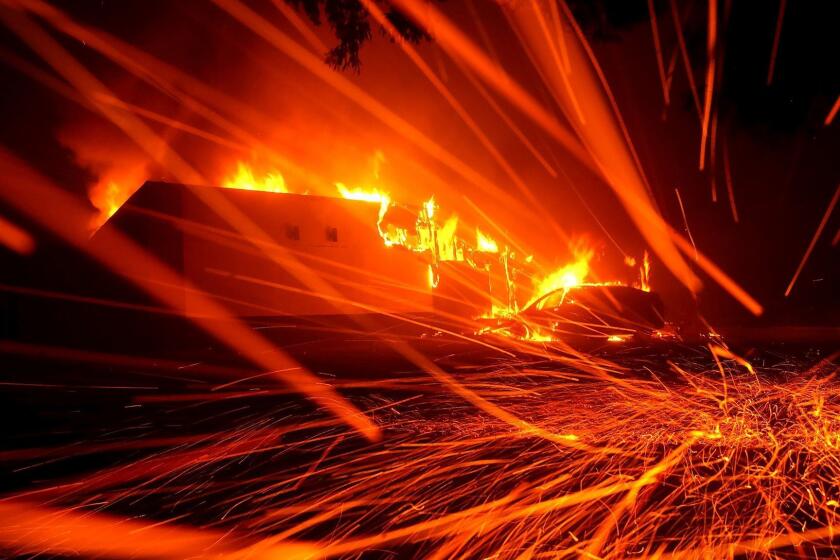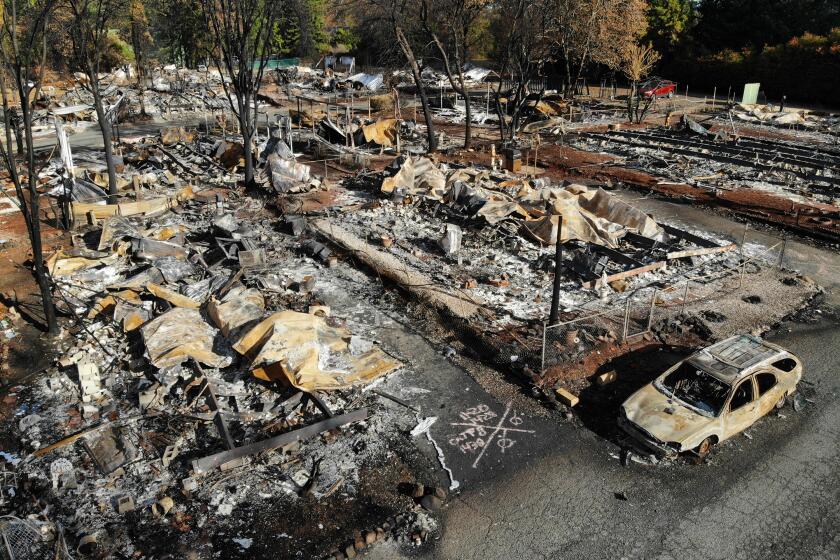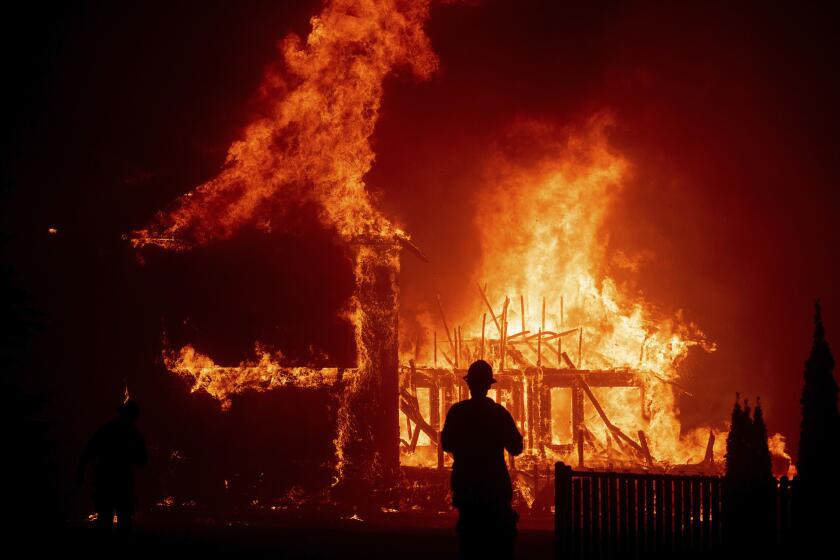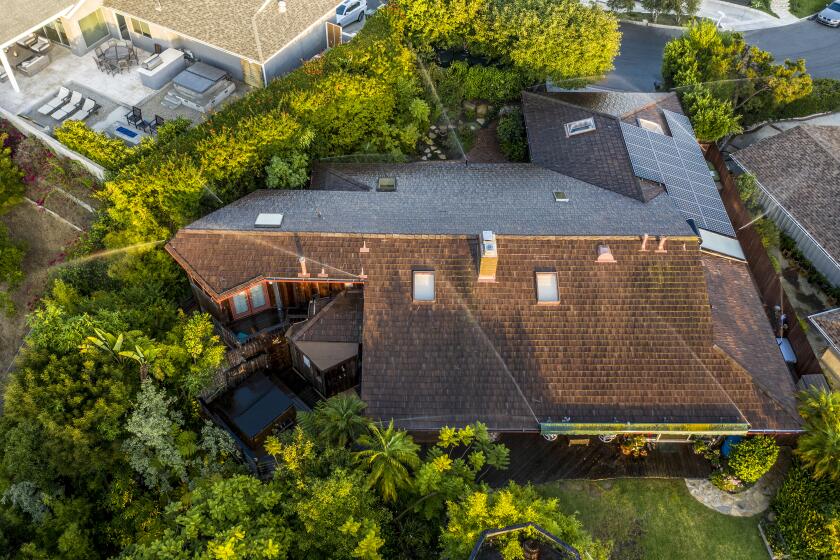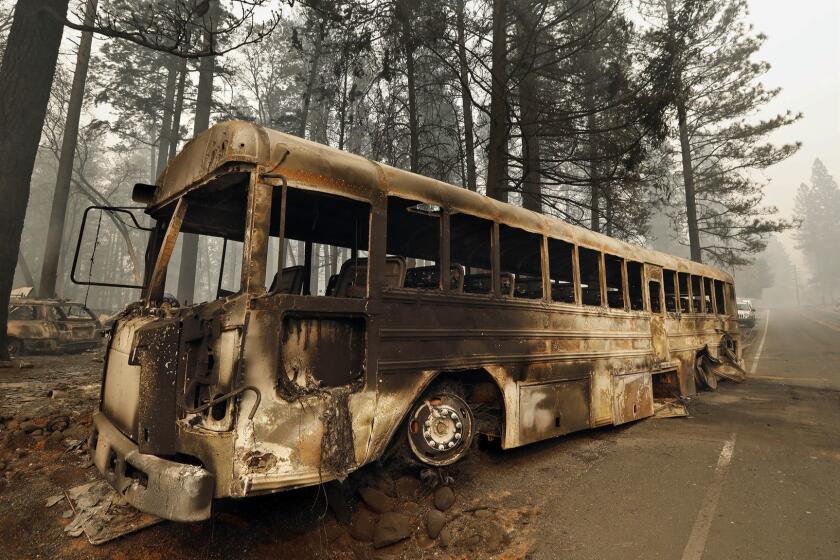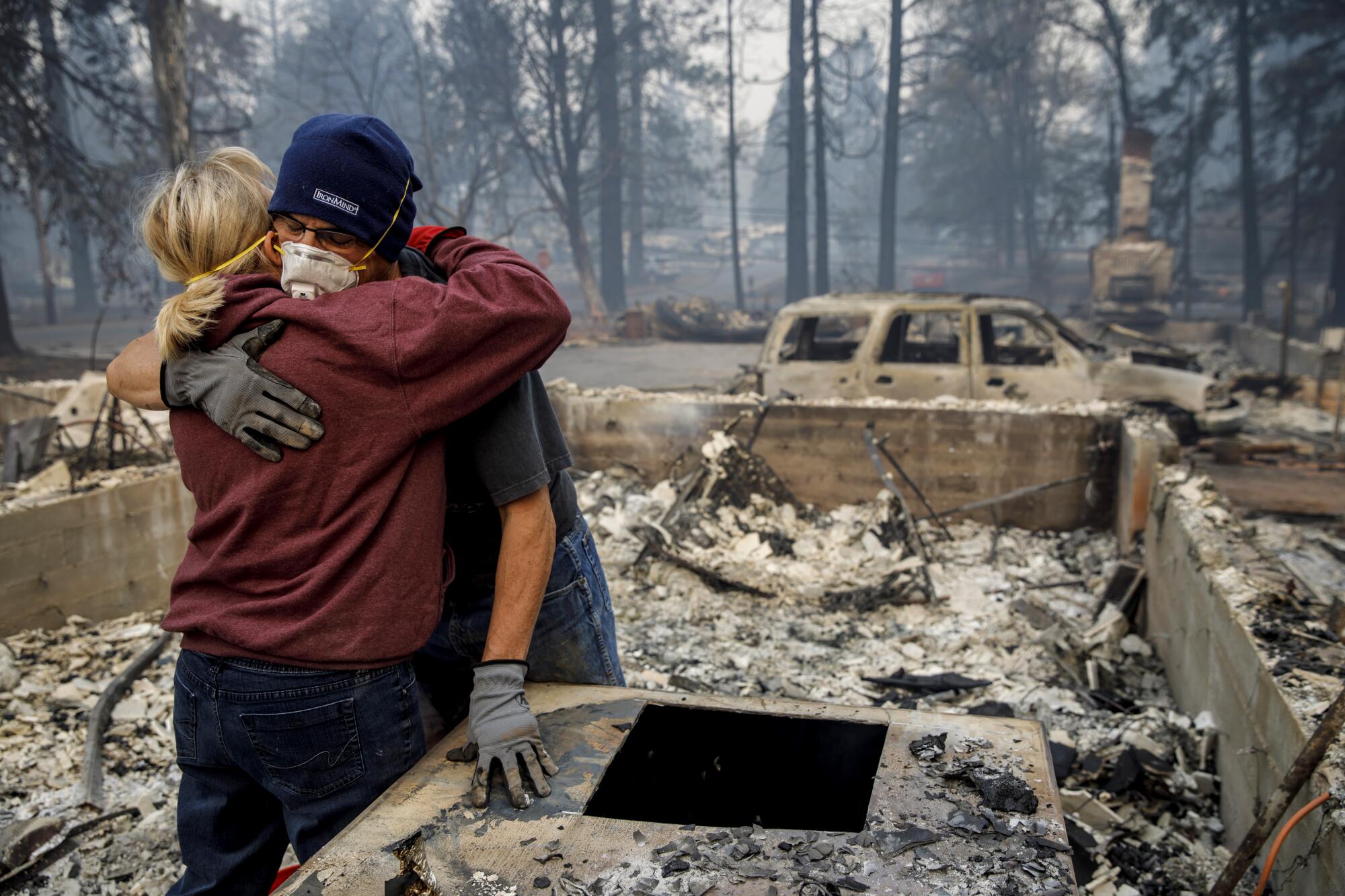
- Share via
Five years ago today, around 6:15 a.m., a Pacific Gas & Electric Co. transmission line in the Sierra Nevada foothills malfunctioned. There was a spark, and soon the spark was a fire.
Flames gnawed through Butte County’s Feather River Canyon, where menacing winds shot through the slot and sent embers aloft, turning the blaze into a fast-moving firestorm. Within an hour, structures were burning in Concow, three miles away.
By noon, the fire was going strong in the neighboring town of Paradise.
By nightfall, the entire town would be gone.
Aggressive and impactful reporting on climate change, the environment, health and science.
The Camp fire went on to burn 153,000 acres and kill 85 people — the deadliest wildfire in California history.
The inferno shocked the state and the nation, not only for its speed and ferocity, but for the vulnerabilities it revealed about forest management, electrical equipment, city planning and evacuations. Now, on its fifth anniversary, experts say California has made strides against some of those shortcomings — but not enough to guarantee such a tragedy will never occur again.
“There are still some lessons that people can take away from an absolute worst-case scenario, where you have no hope of either fighting the fire or evacuating everyone at the same time,” said Jim Broshears, who was Paradise’s emergency management director on that fateful day.
“We’re making progress,” he said, “but I would say that there’s still thousands of communities that could experience the same kind of catastrophic emergency. Certainly hundreds.”
The fate of Paradise was cast long before a windstorm last month fueled the deadliest fire in California history.
In some ways, not even the best emergency management planners could have foreseen such a scenario at the time, said Broshears, who also served as Paradise’s longtime fire chief and is currently its emergency operations coordinator. The Camp fire moved at a rapid clip — roughly 80 football fields per minute — and tens of thousands of embers rained down from one end of the town to the other, an area roughly 5 miles long and 3 miles wide. Some embers were the size of a pie plate.
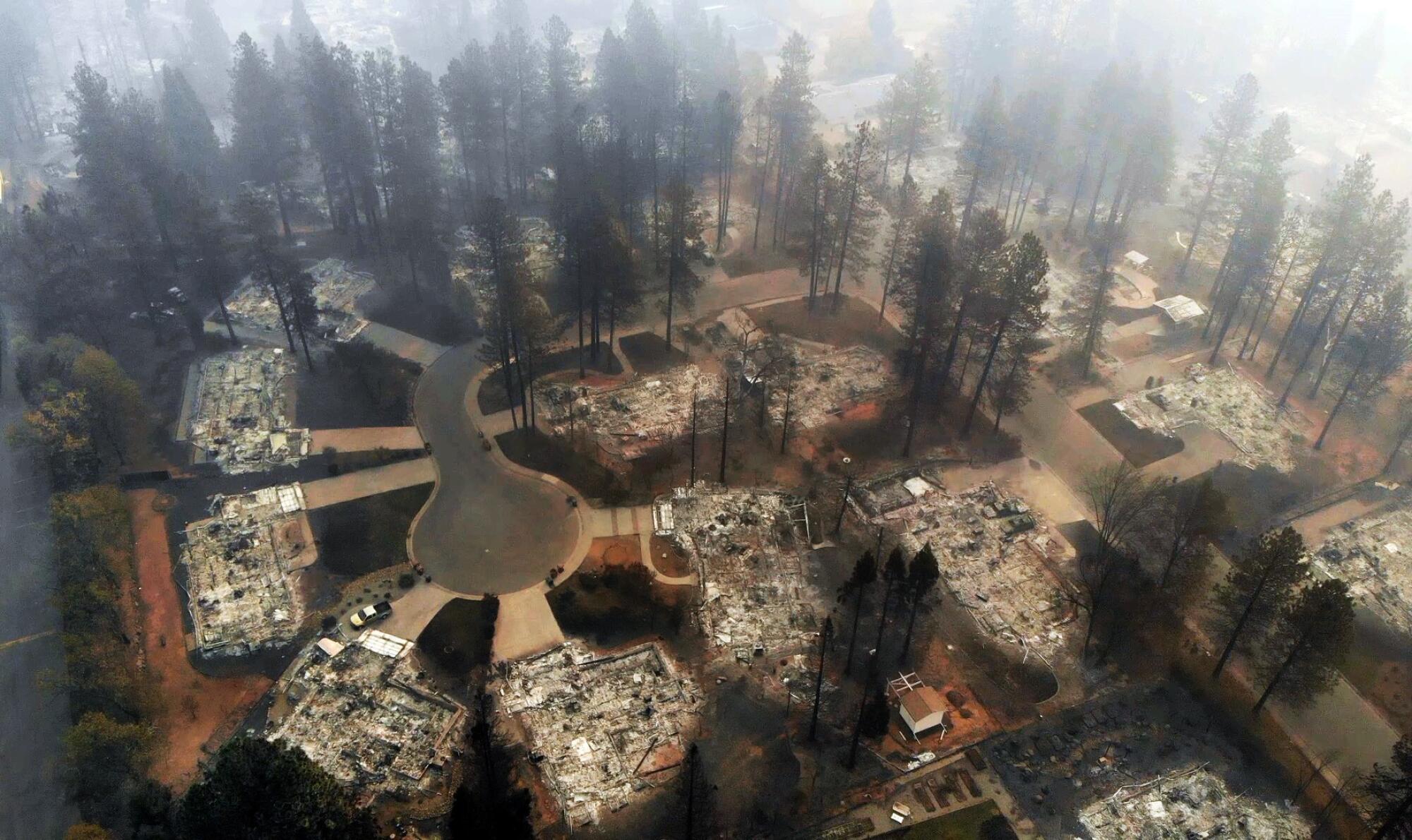
But there were failures. At the time of the blaze, nearly all homes in Paradise had been built before the implementation of fire-resistant improvements to the state’s building code in 2008 — the same year another fire leveled 74 houses in the area. The town’s main thoroughfares had recently been “road dieted” from four lanes to two, trapping more cars in traffic as flames overtook them, resulting in at least 7 deaths.
Paradise Mayor Greg Bolin, who was vice mayor at the time of the fire, remembers it well. The normally 20-minute drive out of town took 4½ hours, he said. His own home was destroyed in the blaze, and he only recently finished construction on a new one.
There has been a shift toward better emergency preparedness procedures, but most towns still think catastrophe won’t come to them, Bolin said. “So there’s always important stuff to work on, and I think that gets pushed off to the side because it’s something you hope will never happen.”
California has seen progress, though, including legal, technological and environmental improvements to wildfire planning and response.
Since 2018, the state enacted a spate of legislation to help avoid another Camp fire, said Rebecca Cohen, program director of evacuation and emergency planning at KLD Associates, which helps communities prepare for disasters.
Senate Bill 99 requires cities and counties to identify residential developments in hazard areas that don’t have at least two emergency evacuation routes, while Assembly Bills 747 and 1409 require evacuation route analysis and the regular revision of local hazard mitigation plans. As a result, “emergency planners are doing this in advance now, and I don’t think they were doing that before,” Cohen said.
In the wake of the fire, PG&E asked KLD to simulate how long it would take to evacuate residents from a wildfire in Santa Cruz County. The company’s detailed model accounted for factors such as time of day and roadway design, and has since been used in Berkeley, Laguna Beach, Oakmont, Oceanside, Santa Barbara County and parts of Oregon and Washington.
But evacuation failures were only one element of the devastation in Paradise, which was traced to a high-voltage PG&E transmission line that was nearly a hundred years old.
After the fire, PG&E pleaded guilty to 84 felony counts of involuntary manslaughter and reached a $13.5-billion dollar settlement with victims, insurance companies and state and local agencies for its role in the Camp fire and other California blazes. The company declared bankruptcy in 2019 and exited it in 2020.
Sumeet Singh, PG&E’s executive vice president of operations and chief operating officer, said that in the years since the fire, the company has invested more than $23 billion in new tools and technologies to reduce the risk of future fires. That money has gone toward high-definition cameras with artificial intelligence capability to help monitor wildfire ignitions; drones to conduct remote equipment inspections; weather- and risk-monitoring systems; and power-line safety improvements, among other efforts.
“We’ve evolved from a posture of what I call ‘reacting and responding’ to ‘predicting and preventing,’” Singh said.
But the utility’s aging equipment has been linked to other large fires in recent years, including the 77,000-acre Kincade fire in 2019, the nearly million-acre Dixie fire in 2021 and the 56,000-acre Zogg fire in 2020, which killed 4 people.
PG&E has also been slow to make progress toward its promise of burying 10,000 miles of power lines in high-risk areas where strong winds, downed trees and other elements can lead to fires, with only about 600 miles slated to be completed by the end of the year. In Paradise, it has buried 165 miles, with about 110 left to go.
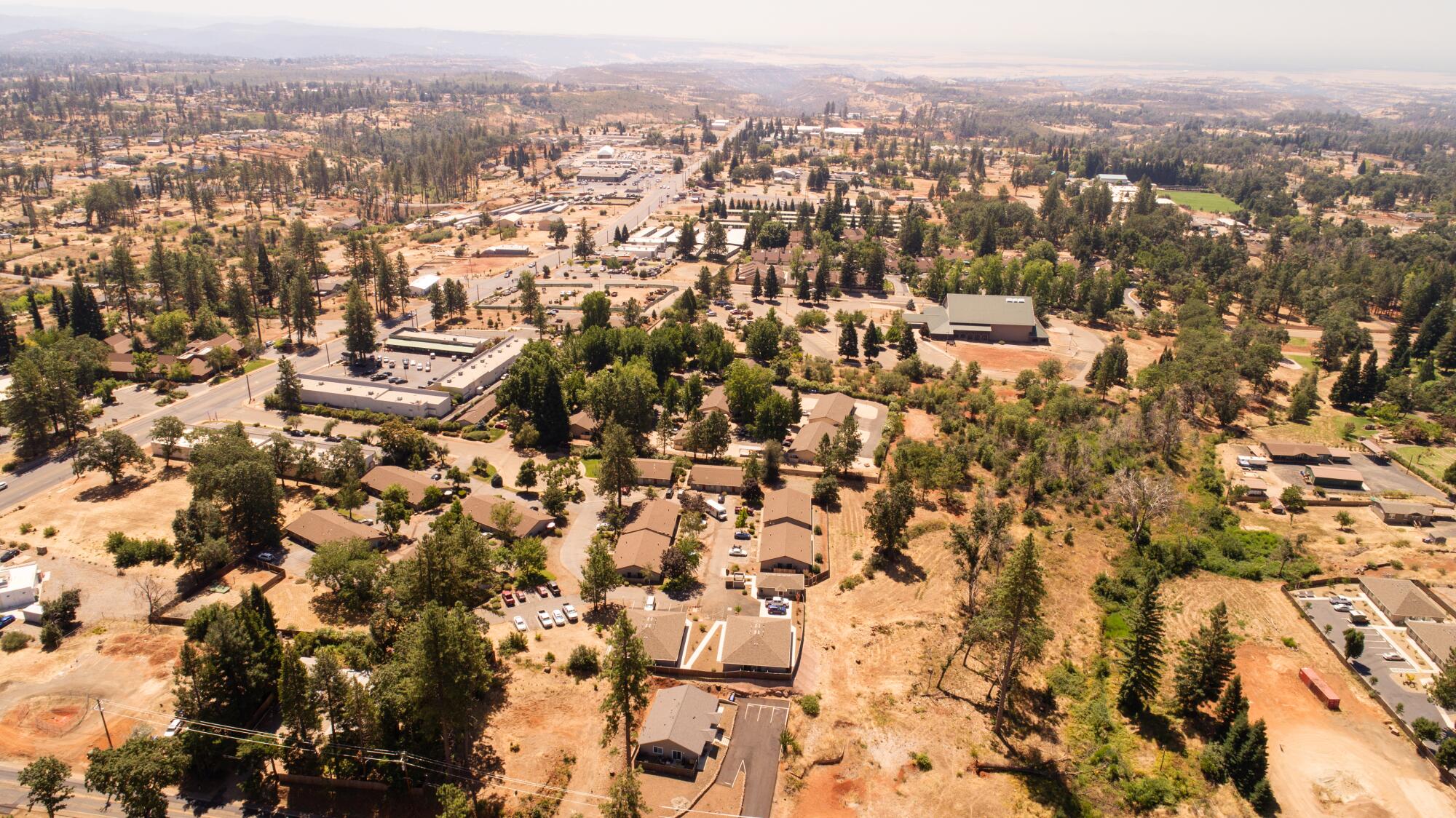
Looking back, Singh said one thing he wished he had known before the Camp fire was how rapidly California’s environment was becoming more prone to burn. A state assessment in 2012 found that about 15% of PG&E’s service area was designated as a high fire risk, and by 2018, that had increased to 50%, he said.
“The drought created a lot of dead trees that created a lot of dry fuel on the ground,” he said.
California fire: What started as a tiny brush fire became the state’s deadliest wildfire. Here’s how
Before there was a spark, there was the wind.
Indeed, vegetation played a critical role in the Camp fire’s spread. It chewed through dry trees and brush, thick grass and stands of ember-sprouting gray pine.
In the years since, the California Department of Forestry and Fire Protection has increased its efforts to reduce such fuels through forest thinning and prescribed burns. This past fiscal year, the agency has removed plant material from 54,000 acres and conducted about 37,000 acres of prescribed burns.
Those efforts might benefit communities immediately adjacent to the work, but the overall impact is likely to be small in a state with more than 30 million acres of forestland, said Zeke Lunder, a Chico-based pyrogeographer who also runs The Lookout, a wildfire information website.
Fuel-reduction work is “not necessarily going to fundamentally change the megafire regime,” said Lunder, noting that the Dixie fire burned a nearly million acres despite forest treatments in the area. He added that the Camp fire quickly transitioned from a wildfire to an urban conflagration, which highlights the importance of home-hardening efforts in addition to forest management.
Indeed, a 2021 study published in Fire Ecology found that the ages of homes in the Camp fire was a factor in their odds of survival, along with the distance to other burned structures and nearby canopy cover.
Homes built during the last two decades were much more resilient than older homes, the study found. But the most important factor was a home’s proximity to a nearby burning structure. That’s because extreme radiant heat can crack windows or cause eaves and siding to catch fire, said Eric Knapp, a research ecologist with the U.S. Forest Service’s Pacific Southwest Research Station and one of the study’s authors.
“You can do everything around your house, but if your neighbor doesn’t also do the home hardening and removing flammable objects adjacent to their homes and their house catches fire, it could impact yours,” he said. “It does suggest we really ought to be thinking at the neighborhood scale with fuel reduction. Everybody needs to participate because one house could cause a chain reaction.”
Data gleaned from that study and others have informed improvements to state rules and regulations that better address radiant heat, said Yana Valachovic, a forest advisor with the University of California Cooperative Extension and another of the study’s authors. For instance, a new law will soon require ember-resistant defensible space zones within 5 feet of a home. Those rules would have made a significant difference in the Camp fire, she said.
“We don’t fight earthquakes, tornadoes or hurricanes,” Valachovic said. “We adapt and build smarter. And Paradise really has given us strong information about what that adaptation needs to look like.”
Elaborate sprinkler systems could be a waste of money in protecting your home from wildfire. A better strategy, experts say, is to team up with neighbors to fireproof your entire community.
While building smarter can make a difference, the decision to rebuild in Paradise at all has left some outsiders wondering about the wisdom of tempting fate in a place that’s so prone to burn.
Paradise officials said they’re doing things differently this time around. They’ve updated building codes with input from the National Fire Protection Assn. and the Insurance Institute of Business and Home Safety, a nonprofit research organization that created a designation for homes that meet certain fire resistant standards.
Alex Maranghides, senior fire protection engineer with the federal government’s National Institute of Standards and Technology, said Paradise had done a lot of advance planning prior to the Camp fire, including creating and practicing an evacuation plan, identifying temporary refuge areas where people could take shelter and even replacing batteries in their radio repeaters after being warned of risky conditions.
But officials had not anticipated a blaze that would ignite on the east side of the canyon, cross the Feather River and broadside the entire town, said Maranghides, who has written multiple case study reports on the fire.
“There had been no fire history to lead them to believe that a fire would require a complete community evacuation,” he said. “Fire had never crossed that branch of the Feather River, historically. The Camp fire was the first one that jumped across.”
Since the Camp fire, there have been changes to local rules and regulations that could help avoid a similar disaster, said Steven Hawks, director of wildfire policy for the Insurance Institute for Business and Home Safety. He pointed the state’s new Wildfire and Forest Resilience Task Force, which developed an action plan to mitigate catastrophic wildfire, as well as the relaxation of some California Environmental Quality Act requirements for creating additional evacuation routes.
A 2019 state law encouraged the retrofitting of homes in socially vulnerable communities, Hawks said, which is currently being piloted in five counties.
After a fast-moving fire swept into town a decade ago, burning more than 200 homes and trapping thousands of fleeing residents on gridlocked mountain roads, a grand jury called on officials to improve evacuation routes.
Bolin, the Paradise mayor, said the town’s population has grown from zero on the night of the fire to about 9,400. More than 2,600 homes have received certificates of occupancy, and 600 or 700 new houses are in varying stages of construction at any given time.
When asked why people are rebuilding in such a fire-prone area, Bolin said it’s not all that different from people in Los Angeles building in places that are prone to earthquakes.
“There’s always something in this country that can get you,” he said. Besides, “it’s home.”
But Lunder, the pyrogeographer, said Paradise has been resistant to some recommendations, including a proposed ban on rain gutters, which can collect flammable vegetation, and prescribed burns within city limits.
He also argued that worsening wildfires are a social problem as much as they are a problem of forest management and urban design — particularly as poverty, political divisions and other factors drive more people into the wildland-urban interface. He said he was not convinced that there was any technical solution that can prevent such a fire from happening again.
“There’s all sorts of great ideas about how we can pull it off, but when it comes down to it, we’ve got some of the most productive land in the world for growing vegetation, we’ve got climate change, we’ve got crazy topography that makes access difficult, we’ve got impoverished counties, we’ve got spiraling construction costs including road construction, and this crazy patchwork of overlapping jurisdictions that are often competing,” he said. “So I don’t feel like I’ve got any sort of magic bullet for how you’re going to make a place like Paradise resilient.”
Paradise, Calif., was devastated by the Camp fire in 2018. Five years later, its residents have mixed feelings on the town that has risen from the ashes, and the lives they have rebuilt.
Broshears, the town’s emergency operations coordinator, said some California communities reached out after the fire to ask what they could do to prevent a similar catastrophe, but the number of those calls was “less than I would have expected.”
Paradise does have lessons to offer, including that evacuation planning can’t stop at a community’s border, he said.
“What’s the next bottleneck down the road that you don’t have control of?” he said. “You have to think regional and not local.”
Paradise has installed 20 of what will be 21 early warning sirens, which sound alerts during emergencies and are now tested once a month. The town has also employed an FM radio alert system along with Code Red alerts that are sent by phone, text and email.
The threat extends well beyond California. On Maui, Hawaii, this summer, a similar scenario played out as a firestorm swept through the town of Lahaina and killed at least 98 people. Some experts fear the lessons of these disasters are short-lived.
“In general, I’d say that interest in wildfires and wildfire evacuations is directly related to how recently a wildfire disaster has occurred and where it happened,” said Mike Robinson, director of the Center for Innovative Transportation Solutions at Old Dominion University. “I know that will seem cynical, but we see this again and again for natural disasters. ... Unless the event is recent and in an area people identify with, the lessons learned are fairly quickly forgotten by those not directly involved.”
Looking back to 2018, Broshears said he never could have envisioned that 12,000 homes in the town would burn, and burn so quickly.
“I was a pretty wild dreamer as an emergency planner, I thought. I had these crazy scenarios that people thought were nuts,” he said. “But I didn’t have that one. I do now.”

